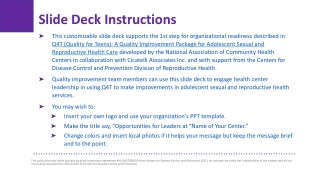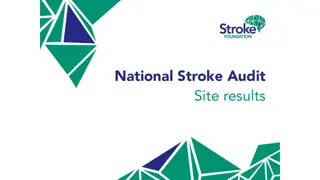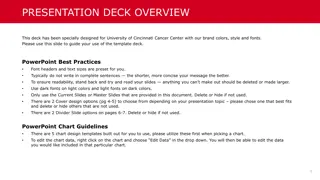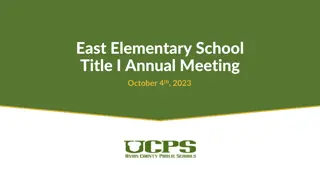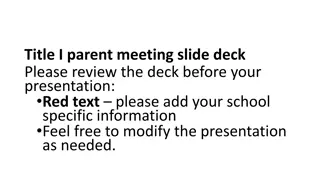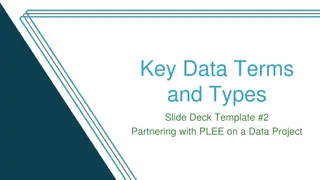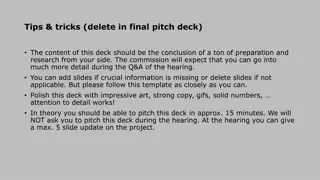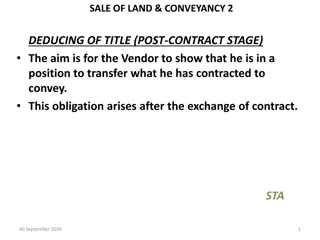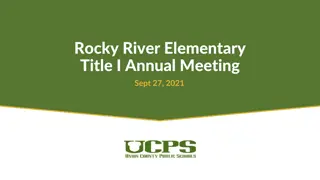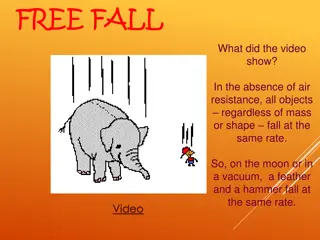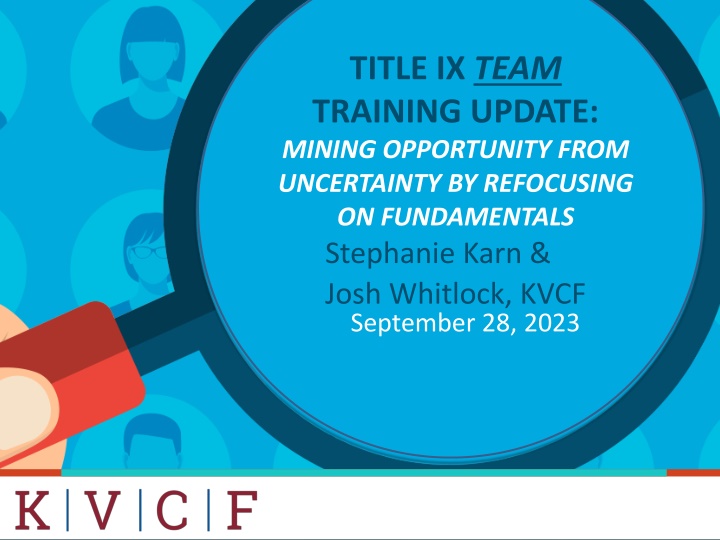
Title IX: Regulations, Procedures, and Compliance
Explore the key aspects of Title IX regulations, grievance procedures, and requirements for educational institutions to ensure compliance and address discrimination and harassment based on sex.
Uploaded on | 1 Views
Download Presentation

Please find below an Image/Link to download the presentation.
The content on the website is provided AS IS for your information and personal use only. It may not be sold, licensed, or shared on other websites without obtaining consent from the author. If you encounter any issues during the download, it is possible that the publisher has removed the file from their server.
You are allowed to download the files provided on this website for personal or commercial use, subject to the condition that they are used lawfully. All files are the property of their respective owners.
The content on the website is provided AS IS for your information and personal use only. It may not be sold, licensed, or shared on other websites without obtaining consent from the author.
E N D
Presentation Transcript
TITLE IX TEAM TRAINING UPDATE: MINING OPPORTUNITY FROM UNCERTAINTY BY REFOCUSING ON FUNDAMENTALS Stephanie Karn & Josh Whitlock, KVCF September 28, 2023
TITLE IX (TIX) MAIN TEXT No person in the United States shall, on the basis of sex, be excluded from participation in, be denied the benefits of, or be subjected to discrimination under any education program or activity receiving assistance. federal financial 20 U.S.C. 1681
PRIMARY PURPOSES AND PROHIBITIONS Prohibits limitations on participation based on sex Focuses on equal funding of men s and women s athletics Prohibits pregnancy discrimination Requirements for how to address Sexual Harassment, Sexual Assault, Stalking, and Domestic/Dating Violence (all specifically defined terms under TIX)
TITLE IX GREIVANCE PROCEDURE REQUIREMENT TIX regulations require that schools "adopt and publish grievance procedures providing for prompt and equitable resolution of student and employee complaints alleging any action that be prohibited by these Title IX regulations [e.g., Sexual Harassment, Sexual Assault, Stalking, Domestic/Dating Violence, and related behaviors]. "
WHAT IS REQUIRED OF A TIX COVERED INSTITUTION ( SCHOOL )? Under TIX, when a TIX covered institution ( school ) has Actual Knowledge, it must respond, investigate and address any alleged discrimination and/or harassment on the basis of sex. Allegations can be made by or against a student or employee of a school, or a third party Regardless of sex, sexual orientation, sexual identity, gender expression or gender identity Prohibited Conduct includes: Sexual Harassment, Sexual Assault, Dating Violence, Domestic Violence, Stalking, and Retaliation Applies only to a school s Education Program or Activity
EDUCATIONAL PROGRAM OR ACTIVITY? All school operations plus locations, events, or circumstances over which the school exercised substantial control over the Respondent and the context in which the alleged behavior occurred Anything on Campus Recognized Student Organizations Labs and Clinics Academics Sponsored Performances and Events Athletics Residence Life Admissions and Hiring Work Study Limited to the United States
INSTITUTIONAL STANDARDS A school must respond promptly in a manner that is not deliberately indifferent. A school is deliberately indifferent only if its response to Sexual Harassment is clearly unreasonable in light of the known circumstances. A school is responsible for the actual knowledge of at least a designated set of senior administrators. Informal Resolution Process may be used for all cases except employee-on-student incidents. Typically, the evidentiary standard is preponderance. Oversight by the Title IX Coordinator
DELIBERATE INDIFFERENCE What does Deliberate Indifference look like? Completely ignoring the situation Failing to investigate a situation when provided with incomplete information Ignoring new acts by a Respondent Discouraging a Complainant from reporting or pursuing a complaint Continuing with the same ineffective directives despite the behavior continuing unabated Failing to recognize a Respondent s position or authority or relevant history of misconduct Failing to follow institutional policies and procedures Allowing violations of no-contact orders without repercussions Failing to file a formal complaint, if a Complainant declines to do so, when needed to protect the community. Failure to contact a Complainant to offer supportive measures and explain the process.
REPORTING OBLIGATIONS Unless designated as a Confidential Resource, all employees are required to promptly report concerns regarding suspected or known discrimination/harassment on the basis of sex to the Title IX Coordinator or a Deputy Title IX Coordinator. Certain Administrators are designated as individuals with authority to institute corrective measures on behalf of the school notice to any of these people/positions typically constitutes knowledge to the school, including: Title IX Coordinator, President, Provost, Directors of Athletics, Human Resources and Students BUT: If the only individual with knowledge is the Respondent, that is NOT notice to the school. Confidential Resources employees designated as such typically will NOT report information about sex discrimination or harassment to other school personnel, including the Title IX Coordinator, unless the person disclosing the information consents to the disclosure or the law requires it (e.g., abuse involving a minor). Include: Chaplain, Counseling, and Health Services. NOTE: Confidential Resources may report non-identifying statistical information for record- keeping and compliance purposes.
REPORTING OBLIGATIONS (CONT.) WHEN IN DOUBT, REPORT. If alleged action does not meet the definitions and requirements of Title IX, it may be covered by another Conduct Policy, and can still be addressed by the school. Most school maintain their commitments to academic freedom but note academic freedom does not allow any form of Sexual Harassment. If not designated as a Confidential Resource, cannot promise confidentiality. Privacy and Disclosure: Except as may be permitted by FERPA or as required by law or to carry out any investigation or resolution of sex discrimination or harassment allegations, [the College] will keep private the identity of any individual who has made a report or complaint of sex discrimination or harassment (including any individual who has made a report or filed a Formal Complaint of Sexual Harassment), any Complainant, any Respondent, and any witness.
INSTITUTIONAL RESPONSE A school sSex Discrimination and Harassment Policy and Title IX Sexual Harassment Grievance Procedures is a very detailed road-map showing how the College will respond to an allegation of sex-based discrimination or harassment. The Policy and Procedures were designed as a result of, and are in compliance with, the U.S. Department of Education s official regulations. The current regulations have been in place since 2020. Once a School has Actual Knowledge of Sexual Harassment (or allegations thereof) against a person in the United States in its Education Program or Activity, [it] is obligated to respond and to follow Title IX s specific requirements The Title IX Coordinator or his/her designee will contact the Complainant to discuss the availability of Supportive Measures with or without the filing of a Formal Complaint and to explain to the Complainant the process for filing a Formal Complaint.
INSTITUTIONAL RESPONSE (CONT). Upon receipt of a Formal Complaint (filed by a Complainant or signed by the Title IX Coordinator), the TIX Coordinator or designee will provide written notice of both the allegations and the grievance process to the Complainant and any known Respondent. The written notice will include a statement the Respondent is presumed not responsible for the alleged conduct and a determination regarding responsibility is made at the conclusion of the grievance process. The written notice also will inform the parties they may have an advisor of their choice, who may be, but is not required to be, an attorney and, at appropriate junctures, the parties and their advisors may review and inspect evidence collected during the investigation. Additionally, the written notice will inform the parties of the school s prohibition on knowingly making false statements or knowingly submitting false information during the grievance process. The school will make arrangements to ensure that individuals with disabilities are provided appropriate accommodations, to the extent necessary and available, to participate in its grievance processes.
INSTITUTIONAL RESPONSE (CONT). threats, coercion, discrimination, or harassment (including charges for conduct violations that do not involve sex discrimination or harassment or Sexual Harassment but arising out of the same facts or circumstances as a report or complaint of sex discrimination or harassment or a report or Formal Complaint of Sexual Harassment), and (2) threatened or taken against a person (a) for the purpose of interfering with any right or privilege secured by Title IX, or (b) because the person has made a report or Formal Complaint, testified, assisted, or participated or refused to participate in any manner in an investigation, proceeding, or hearing related to Title IX. TIX Retaliation means (1) any adverse action (including direct and indirect intimidation, Retaliation does not include (1) the exercise of rights protected under the First Amendment, (2) charging an individual with making a materially false statement in bad faith in the course of a grievance proceeding (provided, however, that a determination regarding responsibility alone is not sufficient to conclude that an individual made a materially false statement in bad faith), or (3) good faith actions lawfully pursued in response to a report of prohibited conduct.
DO NOT BE PART OF THE PROBLEM. situation. Recognize that action still may be required even if an alleged victim does not want to participate in the process. Understand that, once an employee has made a report, they may not be a Need to Know employee. Employees may be asked to provide supportive measures for either or both the Complainant and Respondent but may not get the full story. Consider serving as, or asking others to serve as, an Advisor. DO NOT ENGAGE IN PROHIBITED CONDUCT. No one is above the rules. If you see something, say something. Do not assume someone else has already reported the incident or
WHERE THINGS STAND WITH PENDING REGULATORY SHIFT DOE released draft version of proposed amended TIX regulations in July 2022 Final version was expected May 2023 latest Release of final version then delayed by the DOE until October 2023 TIX grievance procedures currently in place (conforming to May 2020 regulations) are still fully binding in meantime
(VERY SHORT ON PURPOSE) PREVIEW OF UPCOMING FINAL TITLE IX RULE New regulations may include: Changes to prohibited conduct definitions Expansion of conduct (and location of conduct) that would require institutional response under TIX Significant changes to grievance procedure requirements Clarification regarding retaliation Expansion of pregnancy-related protections Expansion of TIX coordinator responsibilities
A UNIQUE AND IMPORTANT WINDOW OF OPPORTUNITY! Since 2011, much (most? almost all?) TIX team training has primarily involved reactive efforts to address the latest TIX regulatory swings Very limited opportunity to digest, apply, and fine tune critical fundamentals (with significant impact on team member effectiveness / success) Current pre-regulation release window offers unique opportunity to address that unfortunate deficiency (and control what we can)
ADDRESSING A FUNDAMENTAL, FREQUENT, AND HIGHLY UNFORTUNATE MISUNDERSTANDING Often in this space, there is a failure to fully understand and appreciate the highly specific central purpose of formal resolution (i.e., formal complaint, investigation, hearing, appeal) within TIX grievance procedures Today s main aims are to carefully: Identify and deepen our understanding of that highly specific central formal resolution purpose (including what it isn t); Identify and deepen our understanding of each team member s role in effectively accomplishing that purpose; Leave you with ways to continue deepening your understanding and practicing digestion and application of this critical concept Discuss and practice the highly technical core skills necessary to that purpose; and
NOT THE CENTRAL PURPOSE OF FORMAL RESOLUTION * ancillary/supporting, not central purpose of formal resolution Yellow = important but * Red = total (+ problematic) miss Treating the parties with fairness and respect Conducting a thorough investigation Holding a compliant and effective hearing Providing appropriately robust appeal rights Determining whether the Respondent did something that the decision maker (or other team member) personally deems wrong or punishable Determining whether the Respondent committed a violation based on a personal or commonly applied definition of the prohibited conduct (or anything other than the specific Policy definition)
THE ACTUAL CENTRAL PURPOSE OF FORMAL RESOLUTION Determining whether a preponderance of the evidence establishes that the Respondent engaged in Sexual Harassment (including Stalking, Dating Violence, Domestic Violence, Sexual Assault) as specifically defined by the TIX Grievance Procedure.
REASONS THIS IS FORMAL RESOLUTIONS ACTUAL CENTRAL PURPOSE (AND SO HIGHLY CRITICAL TO DO WELL) Fairness / Promise Keeping Compliance (Contractual + Regulatory) Risk mitigation Deference Fulfillment
WHAT CARRYING OUT THE ACTUAL CENTRAL PURPOSE REQUIRES AND CAN T DO WITHOUT an dissection of the specific prohibited conduct definition in question, including each of its specific elements; and a methodical application of the facts and evidence to that specific definition (and only that specific definition) and each of its specific elements (and only those specific elements) (near surgical exercise) intensely in-depth understanding and
HOW TO (INTENSELY AND IN GREAT DEPTH) UNDERSTAND AND DISSECT PROHIBITED CONDUCT DEFINITIONS 1) 2) Print hard copy of SMPP Carefully read, read, and re-read specific Prohibited Conduct Definition (e.g., Sexual Harassment, Sexual Assault, Dating Violence, Domestic Violence, and Stalking Break down into individual specific elements Highlight key words (e.g., and, or, reasonable ) Cross-check any defined (usually capitalized) terms Re-digest definition, focusing on specific elements Discuss any uncertainty with TIX Coordinator (and/other team members, with TIX Coordinator input/oversight for consistency) Re-review all of the above with every new assignment 3) 4) 5) 6) 7) 8)
PRIMARY TIX TEAM MEMBER ROLES WITH REGARD TO CENTRAL PURPOSE TIXC/ Deputies: Ensure deep understanding by all team members of central purpose of formal resolution + each specific Prohibited Conduct Definition Guide assigned team members through execution of central purpose and serve as definition clarifier (stopping short of matter specific facts/analysis) Investigators: With specific applicable definition(s) and specific elements continually at forefront of their minds, gather and organize facts to paint picture that will enable decision makers to carry out central purpose
PRIMARY TIX TEAM MEMBER ROLES WITH REGARD TO CENTRAL PURPOSE (CONT.) Decision makers: With specific applicable definition(s) and specific elements continually at forefront of their minds, carry out central purpose by methodically applying facts to definition(s) using preponderance standard Appellate decision makers: With specific applicable definition(s) and specific elements continually at forefront of their minds, review previous team members execution of central purpose (within appellate parameters set forth in SMPP)
STALKING DEFINITION AND EXERCISE Stalking means engaging in a course of conduct directed at a specific person that would cause a reasonable person to (i) fear for their safety or the safety of others; or (ii) suffer substantial emotional distress. 1) 2) Print hard copy of SMPP Carefully read, read, and re-read specific Prohib. Cond. Definition (e.g., Sexual Harassment, Sexual Assault, Dating Violence, Domestic Violence, and Stalking) Break down into individual specific elements Highlight key words (e.g., and, or, reasonable Cross-check any defined (usually capitalized) terms Re-digest definition, focusing on specific elements Discuss any uncertainty with TIX Coordinator (and/other team members, with TIX Coordinator input/oversight for consistency) Re-review all of the above with every new assignment 3) 4) 5) 6) 7) 8)
STALKING DEFINITION AND EXERCISE engaging in a course of conduct directed at a specific person that [conduct] would cause a reasonable person to fear for their safety OR the safety of others OR cause a reasonable person to suffer emotional distress
HYPOTHETICAL FACTS AND APPLICATION EXERCISE Jan and John both 18 year old first year students In dating relationship during first semester Broke up during second semester, and Jan asked John not to contact her anymore and blocked his number John began then texting Jan from a different number John sent Jan 48 text messages over a two-day period He didn t threaten violence nor has he ever to her but, in two separate text messages, he referred to still having a copy of the key to Jan s dorm room and said that, if she didn t respond, he would show up there to force her to talk with him and hear him out Text messages seemed increasingly desperate Jan made complaint to TIX office at end of second day of texts and expressed strong desire to pursue formal complaint for Stalking TIX office put in place strict no contact order, which John has so far (during the three- week investigation leading up to the hearing) abided by
MASSIVE UPSIDES OF FULLY UNDERSTANDING AND CARRYING OUT FORMAL RESOLUTION CENTRAL PURPOSE Fairness / Promise Keeping Compliance (Contractual + Regulatory) Risk mitigation Deference Fulfillment Nimbleness within situations and with regard to future shifts
TAKE HOME WORK As a group exercise (potentially in pairs within group), get together in person and follow steps 1-7 (of 8) above for each prohibited conduct definition in SMPP: Sexual Harassment, Sexual Assault, Dating Violence, Domestic Violence, and Stalking Counts as additional training (of the highest caliber and importance)!!! Order pizza and/or food and beverage of choice, incentivize/make it fun however you can, just please do it
Thank You ANY QUESTIONS? skarn@kv-legal.com www.kv-legal.com 804.823.4077

